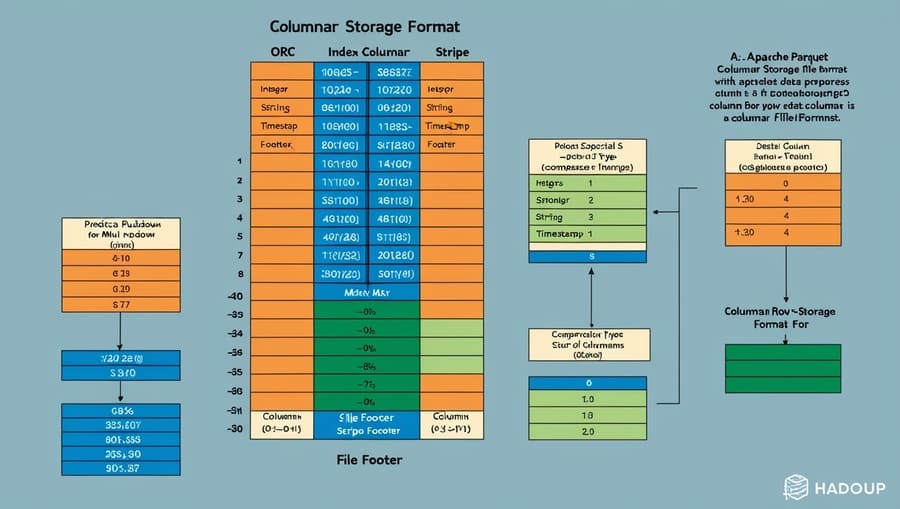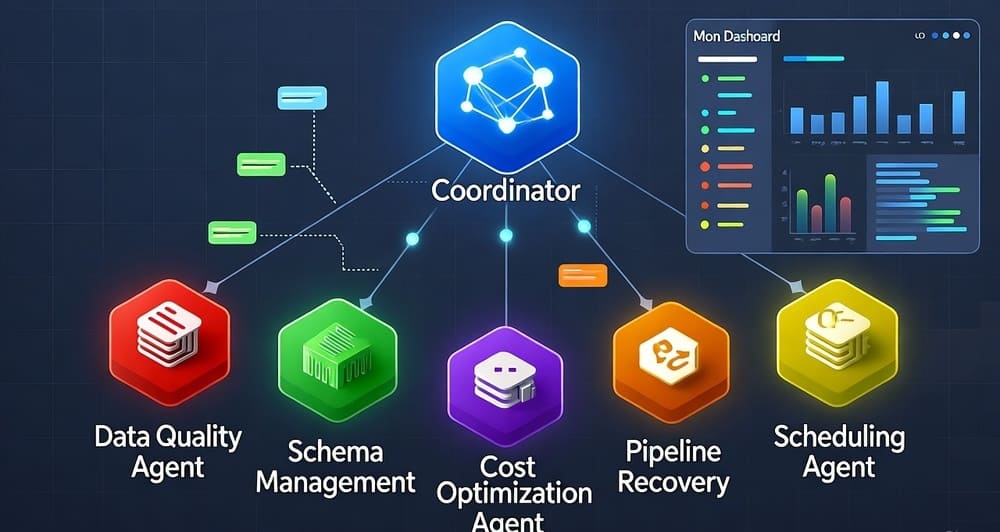ORC (Optimized Row Columnar): The High-Performance Columnar Storage Format Powering Modern Data Lakes
In the ecosystem of big data, storage formats might not seem as exciting as the latest machine learning algorithms or real-time streaming capabilities. Yet, they form the critical foundation upon which data engineering excellence is built. Among these formats, ORC (Optimized Row Columnar) stands out as a masterpiece of engineering designed specifically to address the challenges of processing massive datasets in Hadoop environments.
The Evolution of Hadoop Storage
To appreciate ORC’s significance, we must first understand the historical context. Early Hadoop deployments primarily used text-based formats like CSV or JSON, which were simple but woefully inefficient for analytical workloads. The need for better performance led to the development of more sophisticated formats, with ORC emerging as a powerful solution.
Introduced in 2013 as part of the Apache Hive project (and later becoming its own Apache project), ORC was designed with a clear mission: optimize Hadoop performance for analytical workloads while minimizing storage requirements.
The Technical Architecture of ORC
ORC’s architecture represents a careful balance between performance, compression, and flexibility:
Columnar Storage Foundation
Unlike row-based formats that store all fields of a record together, ORC organizes data by column:
Row format: [name1, age1, city1] [name2, age2, city2] [name3, age3, city3]...
ORC format: [name1, name2, name3...] [age1, age2, age3...] [city1, city2, city3...]This fundamental design choice provides several advantages:
- Query Efficiency: Analytical queries typically access only a subset of columns. ORC allows reading only the needed columns.
- Compression Efficiency: Similar data types grouped together compress much better.
- Encoding Optimization: Each column can use type-specific encoding techniques.
Physical Structure
ORC files are organized into stripes, typically 64MB or larger, each containing:
- Index Data: Min/max values and positions for predicate filtering
- Row Data: The actual columnar data
- Stripe Footer: Metadata about the stripe
The file also includes a file footer with schema information and statistics, and a postscript with compression parameters.
┌─────────────────────── ORC File ────────────────────────┐
│ │
│ ┌─────────┐ ┌─────────┐ ┌─────────┐ │
│ │ Stripe 1 │ │ Stripe 2 │ ... │ Stripe n │ │
│ └─────────┘ └─────────┘ └─────────┘ │
│ │
│ ┌───────────┐ ┌──────────┐ ┌───────────┐ │
│ │ File Stats │ │ Metadata │ │ File Footer │ ┌──────────┐ │
│ └───────────┘ └──────────┘ └───────────┘ │ Postscript │ │
│ └──────────┘ │
└─────────────────────────────────────────────────────────┘Advanced Features
ORC implements several advanced features:
1. Intelligent Indexing
Each stripe contains three levels of indexing:
- File-level statistics: Min/max values for the entire file
- Stripe-level statistics: Min/max values per stripe
- Row-group level indexes: Fine-grained indexes within stripes
These enable predicate pushdown, allowing ORC to skip entire stripes or row groups that can’t match query conditions, dramatically speeding up processing.
2. Type-Specific Encodings
ORC employs specialized encodings for different data types:
- Integer values: Run-length encoding and variants
- String values: Dictionary encoding for repeated values
- Timestamp values: Specialized delta encoding
3. Built-in Compression
ORC supports multiple compression algorithms, with zlib as the default:
- ZLIB: Good compression ratio, moderate speed
- Snappy: Lower compression ratio, very high speed
- LZO: Balance between ratio and speed
- ZSTD: Excellent compression ratio with good speed (added in later versions)
4. Schema Evolution
ORC supports adding, dropping, and modifying columns without requiring data rewrites:
- New columns are added with null values for existing records
- Dropped columns are simply ignored during reading
- Type changes are supported within compatible types (e.g., int to long)
ORC in Action: Performance Benefits
Let’s explore ORC’s performance benefits through some practical examples:
Storage Efficiency
Consider a dataset with 1 billion records, each with 20 columns of mixed types. Approximate sizes:
- CSV format: 200 GB
- JSON format: 350 GB
- Parquet format: 50 GB
- ORC format: 40 GB
ORC typically achieves 30-75% better compression compared to row-based formats, with further improvements when using advanced compression like ZSTD.
Query Performance
ORC’s design particularly shines in analytical queries. For example:
sql-- Query selecting a subset of columns with filtering
SELECT customer_id, total_amount
FROM transactions
WHERE transaction_date BETWEEN '2023-01-01' AND '2023-01-31'
AND store_id = 42;
On this type of query, ORC typically delivers:
- 10-20x faster execution compared to text formats
- 2-4x reduction in I/O compared to row-based formats
- 30-70% improvement in CPU utilization through vectorized reads
Predicate Pushdown in Action
ORC’s indexing enables predicate pushdown, which can dramatically reduce the amount of data read:
sql-- Query with high selectivity
SELECT * FROM inventory
WHERE product_category = 'Electronics'
AND stock_level < 10
AND last_restock_date < '2023-01-01';
With predicate pushdown on an ORC file:
- ORC first examines file-level statistics to see if the file could contain matching records
- For qualifying files, it checks stripe-level statistics to identify relevant stripes
- Within relevant stripes, it uses row-group indexes to read only necessary row groups
This process can often reduce data reads by 90-99% compared to formats without such indexing.
Implementing ORC in Your Data Architecture
Storage Pattern Best Practices
When implementing ORC in your data lakes or warehouses, consider these best practices:
1. Stripe Size Optimization
xml<!-- Hive configuration for ORC stripe size -->
<property>
<name>hive.exec.orc.stripe.size</name>
<value>134217728</value> <!-- 128 MB -->
</property>
Larger stripes (64-256MB) improve compression and processing efficiency for batch workloads, while smaller stripes can be better for interactive queries.
2. Row Group Size Tuning
xml<property>
<name>hive.exec.orc.default.row.index.stride</name>
<value>10000</value> <!-- 10,000 rows per row group -->
</property>
Row group size affects index granularity. Larger values reduce index size but provide less precise filtering.
3. Compression Selection
sql-- Setting compression in Hive
CREATE TABLE transactions (
transaction_id BIGINT,
customer_id INT,
amount DECIMAL(12,2),
transaction_date TIMESTAMP
)
STORED AS ORC
TBLPROPERTIES ("orc.compress"="ZSTD");
Choose compression based on your workload:
- Zstandard (ZSTD): Best choice for most modern deployments
- Snappy: When processing speed is critical
- ZLIB: When storage cost is the primary concern
4. Partition Strategy
ORC works exceptionally well with partitioned data:
sql-- Partitioned table in Hive
CREATE TABLE sales (
sale_id BIGINT,
product_id INT,
quantity INT,
amount DECIMAL(12,2)
)
PARTITIONED BY (sale_date DATE)
STORED AS ORC;
Effective partitioning multiplies the benefits of ORC’s predicate pushdown capabilities.
Integration with Big Data Tools
ORC integrates well with the Hadoop ecosystem:
Apache Hive
ORC is natively supported in Hive and works particularly well with Hive’s vectorized execution engine:
sql-- Enable vectorized execution in Hive
SET hive.vectorized.execution.enabled = true;
SET hive.vectorized.execution.reduce.enabled = true;
-- Query ORC data
SELECT
store_id,
SUM(sales_amount) as total_sales
FROM store_sales
WHERE sale_date >= '2023-01-01'
GROUP BY store_id
ORDER BY total_sales DESC
LIMIT 10;
Apache Spark
Spark provides excellent ORC support:
scala// Scala: Reading ORC with Spark
val transactions = spark.read.orc("s3://data-lake/transactions/")
// Writing ORC with specific compression
transactions.write
.option("orc.compress", "ZSTD")
.orc("s3://data-lake/transactions_processed/")
Presto/Trino
Presto and its fork Trino offer optimized ORC readers:
sql-- Presto query on ORC data
SELECT
region,
product_category,
SUM(sales) as total_sales
FROM sales
WHERE year = 2023 AND month BETWEEN 1 AND 3
GROUP BY ROLLUP (region, product_category)
ORDER BY region, total_sales DESC;
Conversion from Other Formats
Transitioning to ORC from other formats is straightforward:
sql-- Converting from CSV to ORC in Hive
CREATE TABLE sales_orc
STORED AS ORC
AS
SELECT * FROM sales_csv;
python# Converting to ORC using PySpark
from pyspark.sql import SparkSession
spark = SparkSession.builder.appName("ConvertToORC").getOrCreate()
# Read from source format
df = spark.read.parquet("s3://data-lake/raw-data/")
# Write as ORC with Zstandard compression
df.write.option("orc.compress", "ZSTD").orc("s3://data-lake/optimized-data/")
ORC vs. Other Storage Formats
Understanding how ORC compares to alternatives helps in making informed architecture decisions:
ORC vs. Parquet
Both ORC and Parquet are columnar formats with similar goals but different strengths:
- Compression: ORC typically achieves better compression ratios
- Hadoop Integration: ORC is more tightly integrated with the Hadoop/Hive ecosystem
- Encoding: Parquet uses more complex encodings that can be more efficient for some data types
- Schema Evolution: ORC has more robust schema evolution capabilities
- Community: Parquet has wider adoption outside the Hadoop ecosystem
ORC vs. Avro
Avro and ORC serve different primary use cases:
- Storage Model: Avro is row-based; ORC is columnar
- Use Case Focus: Avro excels at record-level processing; ORC at analytical queries
- Schema Evolution: Both support schema evolution but with different approaches
- Splitting: Both are splittable formats, important for parallel processing
ORC vs. Traditional Formats (CSV, JSON)
Compared to traditional formats, ORC offers:
- Size: 75-90% smaller files
- Performance: 10-100x faster query performance
- Schema Enforcement: Strong typing and schema validation
- Predicate Pushdown: Intelligent filtering not possible with text formats
Advanced ORC Features and Techniques
ACID Transactions with ORC
ORC is the underlying storage format for Hive ACID tables, enabling transactions in Hadoop:
sql-- Creating a transactional table in Hive
CREATE TABLE customers (
id INT,
name STRING,
email STRING,
last_update TIMESTAMP
)
STORED AS ORC
TBLPROPERTIES (
"transactional"="true",
"orc.compress"="ZSTD"
);
-- Performing updates
UPDATE customers
SET email = 'new.email@example.com', last_update = CURRENT_TIMESTAMP
WHERE id = 42;
The ACID implementation uses ORC’s capabilities to track record versions and maintain consistency.
Advanced Analytics Optimization
For complex analytical queries, additional optimizations can be applied:
sql-- Enable Bloom filters for specific columns
SET hive.exec.orc.create.bloom.filter = true;
SET hive.exec.orc.bloom.filter.columns = customer_id,product_id;
-- Set dictionary encoding threshold
SET hive.exec.orc.dictionary.key.size.threshold = 0.8;
Bloom filters provide additional filtering capabilities for high-cardinality columns, significantly improving join performance.
Data Skipping Techniques
ORC’s statistics enable sophisticated data skipping:
┌────────────────────────────────────────┐
│ Column: product_id │
├────────────────┬───────────┬───────────┤
│ Stripe │ Min Value │ Max Value │
├────────────────┼───────────┼───────────┤
│ Stripe 1 │ 1000 │ 2500 │
│ Stripe 2 │ 2200 │ 3800 │
│ Stripe 3 │ 3600 │ 5000 │
└────────────────┴───────────┴───────────┘For a query like WHERE product_id = 3000, ORC would:
- Skip Stripe 1 entirely (max value too low)
- Process Stripe 2 (range includes 3000)
- Process Stripe 3 (range includes 3000)
This data skipping becomes even more powerful when combined with partitioning and row group indexes.
Real-World Use Cases for ORC
1. Data Warehousing
ORC shines in data warehousing scenarios:
sql-- Example data warehousing query
SELECT
dim_date.year,
dim_date.quarter,
dim_product.category,
dim_customer.segment,
SUM(fact_sales.quantity) as units_sold,
SUM(fact_sales.amount) as total_sales
FROM fact_sales
JOIN dim_date ON fact_sales.date_key = dim_date.date_key
JOIN dim_product ON fact_sales.product_key = dim_product.product_key
JOIN dim_customer ON fact_sales.customer_key = dim_customer.customer_key
WHERE dim_date.year BETWEEN 2020 AND 2023
GROUP BY
dim_date.year,
dim_date.quarter,
dim_product.category,
dim_customer.segment
ORDER BY
dim_date.year,
dim_date.quarter,
total_sales DESC;
ORC’s columnar nature and predicate pushdown make such complex analytical queries dramatically faster.
2. Log Analytics
For log processing pipelines, ORC offers significant advantages:
Raw Logs → JSON Format → Parsing → ORC Conversion → AnalyticsConverting logs to ORC typically:
- Reduces storage by 85-95%
- Improves query speed by 10-50x
- Enables sophisticated analysis previously impractical
3. IoT Data Processing
IoT data typically involves:
- High volume time-series data
- Many dimensions for analysis
- Range-based queries on time windows
ORC’s structure makes it ideal for storing and analyzing such data efficiently.
Future Directions for ORC
ORC continues to evolve with several exciting developments:
1. Enhanced Encryption
Column-level encryption capabilities allow sensitive data to be protected while still enabling analytics:
sql-- Example of encrypted columns (conceptual)
CREATE TABLE customer_data (
customer_id INT,
name STRING,
email STRING ENCRYPTED WITH (KEY = 'email_key'),
ssn STRING ENCRYPTED WITH (KEY = 'pii_key'),
address STRING ENCRYPTED WITH (KEY = 'pii_key'),
preferences STRING
)
STORED AS ORC;
2. Improved Integration with Compute Engines
New features focus on better integration with modern compute engines:
- Direct integration with GPU-accelerated analytics
- Native support in cloud data warehouses
- Optimizations for containerized environments
3. Advanced Compression and Encoding
Research continues into more efficient compression and encoding schemes:
- Improved dictionary encoding for complex types
- Adaptive compression selection based on data characteristics
- Specialized encoding for spatial and temporal data
Conclusion
ORC represents a remarkable achievement in storage format design, delivering exceptional performance for analytical workloads while maintaining the flexibility needed for evolving data environments. Its columnar structure, combined with advanced features like intelligent indexing, predicate pushdown, and type-specific encoding, makes it an excellent choice for data lakes and warehouses built on Hadoop technology.
In the modern data ecosystem, where organizations must process ever-increasing volumes of data while controlling costs, ORC offers a compelling combination of efficiency, performance, and integration with the broader Hadoop landscape. Whether you’re building a new data platform or optimizing an existing one, ORC deserves serious consideration as your storage format of choice.
By implementing ORC with the best practices and optimization techniques discussed in this article, you can achieve remarkable improvements in query performance, storage efficiency, and overall data platform capabilities. The future of big data demands intelligent storage solutions, and ORC stands ready to meet that challenge.
Hashtags: #ORC #ColumnarStorage #Hadoop #BigData #DataEngineering #DataLake #Hive #Spark #DataWarehouse #StorageOptimization





